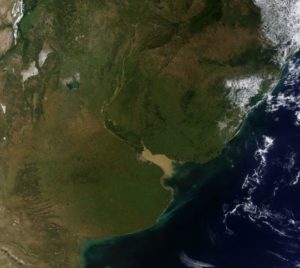Piecuch, C. G., 2023. River effects on sea-level rise in the Río de la Plata estuary during the past century, Ocean Sci., 19, 57–75. https://doi.org/10.5194/os-19-57-2023

View of the Paraná River and the Río de la Plata in South America captured by the Moderate Resolution Imaging Spectroradiometer (MODIS) onboard the Terra satellite captured on March 31, 2022.
Identifying the causes for historical sea-level changes in coastal tide-gauge records is important for constraining oceanographic, geologic, and climatic processes. The Río de la Plata estuary in South America features the longest tide-gauge records in the South Atlantic. Despite the relevance of these data for large-scale circulation and climate studies, the mechanisms underlying relative sea-level changes in this region during the past century have not been firmly established. I study annual data from tide gauges in the Río de la Plata and stream gauges along the Río Paraná and Río Uruguay to establish relationships between river streamflow and sea level over 1931–2014. Regression analysis suggests that streamflow explains ~60% of the total sea-level variance at Buenos Aires, Argentina, and ~30% at Montevideo, Uruguay. A long-term streamflow increase effected sea-level trends of ~0.7 mm yr−1 at Buenos Aires and ~0.5 mm yr−1 at Montevideo. Findings advance understanding of local, regional, and global sea-level changes; clarify sea-level physics; inform future projections of coastal sea level and the interpretation of satellite data and proxy reconstructions; and highlight future research directions. Specifically, local and regional river effects should be accounted for in basin-scale and global mean sea-level budgets as well as reconstructions based on sparse tide-gauge records.
